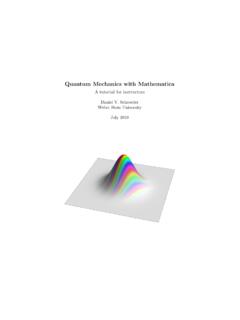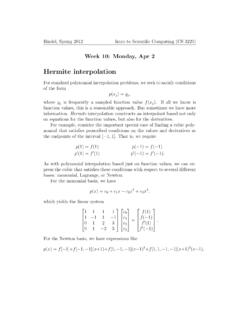Transcription of 9. Harmonic Oscillator - MIT OpenCourseWare
1 9. Harmonic Oscillator Harmonic Oscillator Classical Harmonic Oscillator and model Oscillator Hamiltonian: Position and momentum operators Position representation Heisenberg picture Schro dinger picture Uncertainty relationships Coherent States Expansion in terms of number states Non-Orthogonality Uncertainty relationships X-representation Phonons Harmonic Oscillator model for a crystal Phonons as normal modes of the lattice vibration Thermal energy density and Specific Heat Harmonic Oscillator We have considered up to this moment only systems with a finite number of energy levels; we are now going to consider a system with an infinite number of energy levels: the quantum Harmonic Oscillator ( ). The quantum is a model that describes systems with a characteristic energy spectrum, given by a ladder of evenly spaced energy levels. The energy difference between two consecutive levels is E.
2 The number of levels is infinite, but there must exist a minimum energy, since the energy must always be positive. Given this spectrum, we expect the Hamiltonian will have the form . 1. H |ni = n + ~ |ni , 2. where each level in the ladder is identified by a number n. The name of the model is due to the analogy with characteristics of classical , which we will review first. Classical Harmonic Oscillator and model A classical is described by a potential energy V = 21 kx2 . If the system has a finite energy E, the motion is bound 2. by two values x0 , such that V (x0 ) = E. The equation of motion is given by m ddxx2 = kx and the kinetic energy is 2. p of course T = 12 mx 2 = 2m . The energy is constant since it is a conservative system, with no dissipation. Most of the time the particle is in the position x0 since there the velocity is zero, while at x = 0 the velocity is maximum.
3 The Oscillator in QM is an important model that describes many different physical situations. We will study in depth a particular system described by the , the electromagnetic field. Another system that can be described 79. by this model is solid-state crystals, where the oscillations of nuclei in the lattice can be described as a systems of coupled oscillators (phonons). Notice that any potential with a local minimum can be locally described by an Provided that the energy is low enough (or x close to x0 ), any potential can in fact be expanded in series, giving: V (x) V (x0 ) + b(x x0 )2 + .. 2. where b = ddxV2 |x0 . Oscillator Hamiltonian: Position and momentum operators We can define the operators associated with position and momentum. They are two observables (p,x) with the commutation properties: [x, p] = i~. With these two operators, the Hamiltonian of the quanutm is written as: p2 kx2 p2 1.
4 H= + = + m 2 x2 , 2m 2 2m 2. p where we defined a parameter with units of frequency: = k/m. We use the dimensionless variables, p . P = , X = x m . m . and H = H/ , to simplify the expression to H = (X 2 + P 2 )/2 or H = (X 2 + P 2 ). 2. We have said initially that we expect the hamiltonian to have the form H = (n + 1 ) |ni hn|, if expressed in an 2. appropriate basis. This simply corresponds to diagonalizing the Hamiltonian (thus the basis {|ni} is the energy basis, or the basis formed by the eigenstates of the Hamiltonian). However the diagonalization is not as intuitive as for simple TLS (or n TLS) because we are considering a system with infinite dimensions. The operator H = (n + 1 ) |ni hn| is our guess for the diagonalized form of the Hamiltonian, which makes explicit the 2. presence of energy levels, labeled by n. Correspondingly, there must be operators that act on the ladder of energy levels.
5 For example, the fundamental operations possible are the raising or lowering of 1 quantum of energy, as well as an operator giving the number of energy quanta: N |ni = n |ni. The raising and lowering operators act as the following: a |ni |n 1i and a |ni |n + 1i. They are also called the annihilation and creation operators, as they destroy or create a quantum of energy. Instead of deriving rigorously these operators, we guess their form in terms of the X and P operators: . a = 12~ (X + iP ) = 12~ ( m x + m . i p). 1 1 i a = 2~ (X iP ) = 2~ ( m x m p), and we will check a posteriori that indeed they act as annihilation and creation operators. Notice that a, a are not hermitian, but they are one the hermitian conj ugate of the other (a = (a ) ). Also, we define the number operator as N = a a. The commutation properties are: a, a = 1 and [N, a] = a, N, a = a . Also we have: q x = 2m ~.
6 (a + a). q p = i m ~ . 2 (a a). ? Question: Prove the commutation relationships of the raising and lowering operators. 1 1 i i [a, a ] = [X + iP, X iP ] = ([X, iP ] + [iP, X]) = [X, P ] = [x, p] = 1. 2~ 2~ ~ ~. So we also have aa = [a, a ] + a a = 1 + a a = 1 + N . [N, a] = [a a, a] = [a , a]a = a and [N, a ] = [a a, a ] = a [a, a ] = a . Notice that from now on we will take as usual ~ = 1. 80. From the commutation relationships we have: a |ni = [a, N ] |ni = an |ni N a |ni N (a |ni) = (n 1)(a |ni), that is, a |ni is also an eigenvector of the N operator, with eigenvalue (n 1). Thus we confirm that this is the lowering operator: a |ni = cn |n 1i. Similarly, a |ni is an eigenvector of N with eigenvalue n + 1: . a |ni = N, a |ni = N a |ni a n |ni N (a |ni) = (n + 1)(a |ni). We thus have a |ni = cn |n 1i and a |ni = dn |n + 1i. What are the coefficients cn , dn ? Since hn| N |ni = hn| a a |ni = n and hn| a a |ni = (han|)(a |ni) = hn 1|n 1ic2n.
7 We must have cn = n. Analogously, since aa = N + 1, as seen from the commutation relationship: d2n hn + 1|n + 1i = ha n|a ni = hn| aa |ni hn| (N + 1) |ni = n + 1. So in the end we have : . a |ni = n |n 1i ; a |ni = n + 1 |n + 1i . All the n eigenvalues of N have to be non-negative since n = hn| N |ni = h n1 | n1 i 0 (this follows from the properties of the inner product and the fact that | n1 i = a |ni is just a regular state vector). However, if we apply over and over the a (lowering) operator, we could arrive at negative numbers n: we therefore require that a |0i = 0. to truncate this process. The action of the raising operator a can then produce any eigenstate, starting from the 0. eigenstate: (a )n |ni = |0i . n! The matrix representatio n of these operator in the |ni basis (with infinite-dimensional matrices) is particularly simple, since hn| a |n i = n ,n 1 n and hn| a |n i = n ,n+1 n + 1.
8 0 1 0 .. 0 0 0 .. a= 0 0 2 .. a = 1 0 0 .. 0 0 0 .. 0 2 0 .. The Hamiltonian can be written in terms of these operators. We substitute a, a at the place of X and P , yielding H = (a a + 21 ) = (N + 21 ) and the minimum energy ~ /2 is called the zero point energy. Position representation We have now started from a (physical) description of the Hamiltonian and made a change of basis in order to arrive at a simple diagonal form of it. Now that we know its eigenkets, we would like to go back to a more intuitive picture of position and momentum. We thus want to express the eigenkets |ni in terms of the position representation (see also section ). R. RThe position representation corresponds to expressing a state vector | i in the position basis: | i = dx hx| i |xi =. dx (x) |xi (where |xi is the eigenstate of the position operator that is a continuous variable, hence the integral).
9 This defines the wavefunction (x) = hx| i. The wave function description in the x representation of the quantum can be found by starting with the ground state wavefunction. Since a |0i = 0 we have 12 (X + iP ) |0i = 12 ( m x + im p ) |0i = 0. In the x representation, given 0 (x) = hx| 0i 1 ip d 2. hx| ( m x + ) |0i = 0 (m x + ) 0 (x) = 0 0 (x) e m x /2. 2 m dx 81. (a )n The other eigenstates are built using hermite polynomials Hn (x), using the formula31 |ni = . n! |0i to derive differential equations: n 1 1 d n (x) = hx| ni = m x 0 (x). n!2n m dx with solutions n (x) = hx| ni = 1 H (x) 0 (x). 2n n! n The n = 2 and n = 3 wavefunctions are plotted in the following figure, while the second figure displays the probability distribution function. Notice the different parity for even and odd number and the number of zeros of these functions. -4 -2 2 4. -4 -2 2 4. Fig. 12: Left: Harmonic Oscillator wavefunction.
10 Right: corresponding probability distribution function for n = 2 (blue) and n = 3 (Red, dotted). Classically, the probability that the oscillating particle is at a given valueqof x is simply the fraction of time that it 2. spends there, which is inversely proportional to its velocity v(x) = x0 1 xx2 at that position. For large n, the 0. probability distribution becomes close to the classical one: -10 -5 5 10. -10 -5 0 5 10. Fig. 13: Left: Harmonic Oscillator wavefunction. Right: corresponding probability distribution function for n = 40. In Red, the classical probability. 31. For more details on hermite polynomials and their generator function, look on Cohen-Tannoudji. Online information from: Eric W. Weisstein. hermite Polynomial. From MathWorld A Wolfram Web Resource. 82. Heisenberg picture We want now to study the time-evolution of the We first start with analyzing the evolution of the operators in the Heisenberg picture.












